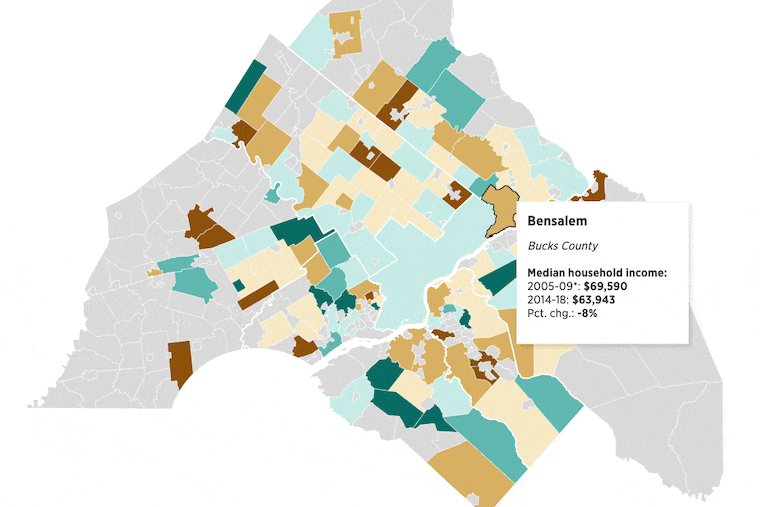Suburban Philadelphia incomes lagged for years. Now there’s COVID carnage and no cushion. | Maria Panaritis
In eight out of 10 households across battleground southeastern Pennsylvania and in South Jersey, income went down or was flat despite huge stock market gains from 2009 to 2018, an Inquirer analysis has found. People are surely suffering even worse now.

Before the economy plunged toward coronavirus catastrophe this year, you would have hoped that, at the very least, it was working well enough to provide most of us a cushion to ride out the storm of 36 million Americans now unemployed.
That has not been the case. Not by a long shot. Most acutely in the suburbs of Philadelphia, some of the most remarkable disappointments of our nation’s economy have played out in ways that do not match political rhetoric that attempts to portray the stock market as proof that Americans have prospered like never before.
An Inquirer analysis of census data shows that in communities across the Southeastern Pennsylvania political battleground suburbs, and in South Jersey — in zip codes long known as stepping-stones or destinations for the middle- and working-class — a majority of residents were struggling to make income gains during the decade of so-called recovery after the Great Recession ended in 2009.
Eight out of 10 suburban residents lived in towns where median incomes either failed to keep up with the rate of inflation, or were flat, or may have grown only modestly above the inflation rate, based on census estimates through the year 2018. At the same time, the S&P 500 stock index rose 178 percent.
In Bensalem Township, whose manufacturing economy in lower Bucks County has suffered years of deindustrialization, median household income was down an estimated 8%, to $63,943 from $69,590.
In Lower Gwynedd, Montgomery County, where pharmaceutical powerhouse Merck last year off-loaded a massive building and 154 acres in a sale to Gwynedd Mercy University, median household income dropped 14% to $101,116. (It had been about $117,851 in 2009.)
In Upper Darby, one of the highest-population townships in Pennsylvania, median income dropped 9% to $54,870. With a dense mix of blue-collar and white-collar employees, it is experiencing a surge in hunger since the pandemic began.
In Gloucester County, N.J., Deptford Township saw median income fall 8% to $70,957, not unlike in Burlington County’s Burlington Township, where income dropped 11% to $88,135.
Unsurprisingly, some of the most high-income enclaves whose expensive housing are barriers to entry for many middle-class families enjoyed durability to their affluence: Radnor saw income rise 9% to $114,063; Tredyffrin notched a 13% gain to $129,332; and Haddonfield, and Moorestown, N.J., saw 14% and 10% income gains, respectively.
Lower-paying retail jobs and small businesses have replaced many steel, and even clerical jobs that once provided strong middle-class wages in the region. That is especially true in Lower Bucks County, said Robert Cormack, after I told the longtime executive director of the Bucks County Economic Development Corp. about ongoing income declines there.
Donald Trump sent Mike Pence to hard-hit Bensalem Township four years ago for a rally ahead of the election. And yet, the data show no substantial turnaround in median incomes even well into the Trump presidency.
Local officials across the suburbs are desperate for Gov. Tom Wolf to somehow boost testing sufficiently so that businesses can open back up. But this cannot happen unless federal officials also provide funding and resources they have not yet ponied up.
“Too many people are not working at this point,” Carmack said. “We need to get them back into their jobs.”
If only those jobs hadn’t left them so close to the precipice to begin with.
Graphics editor John Duchneskie contributed to this article.